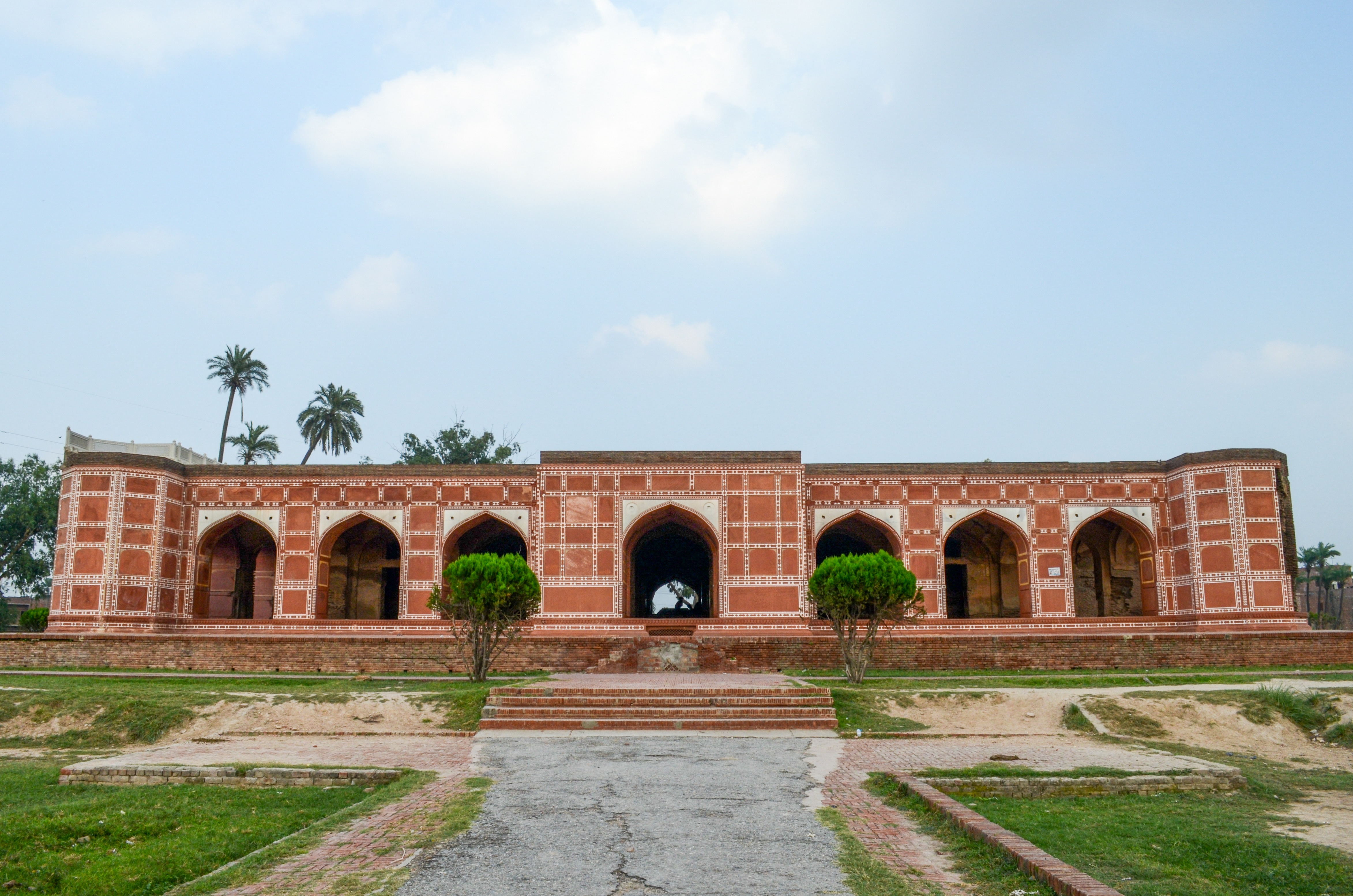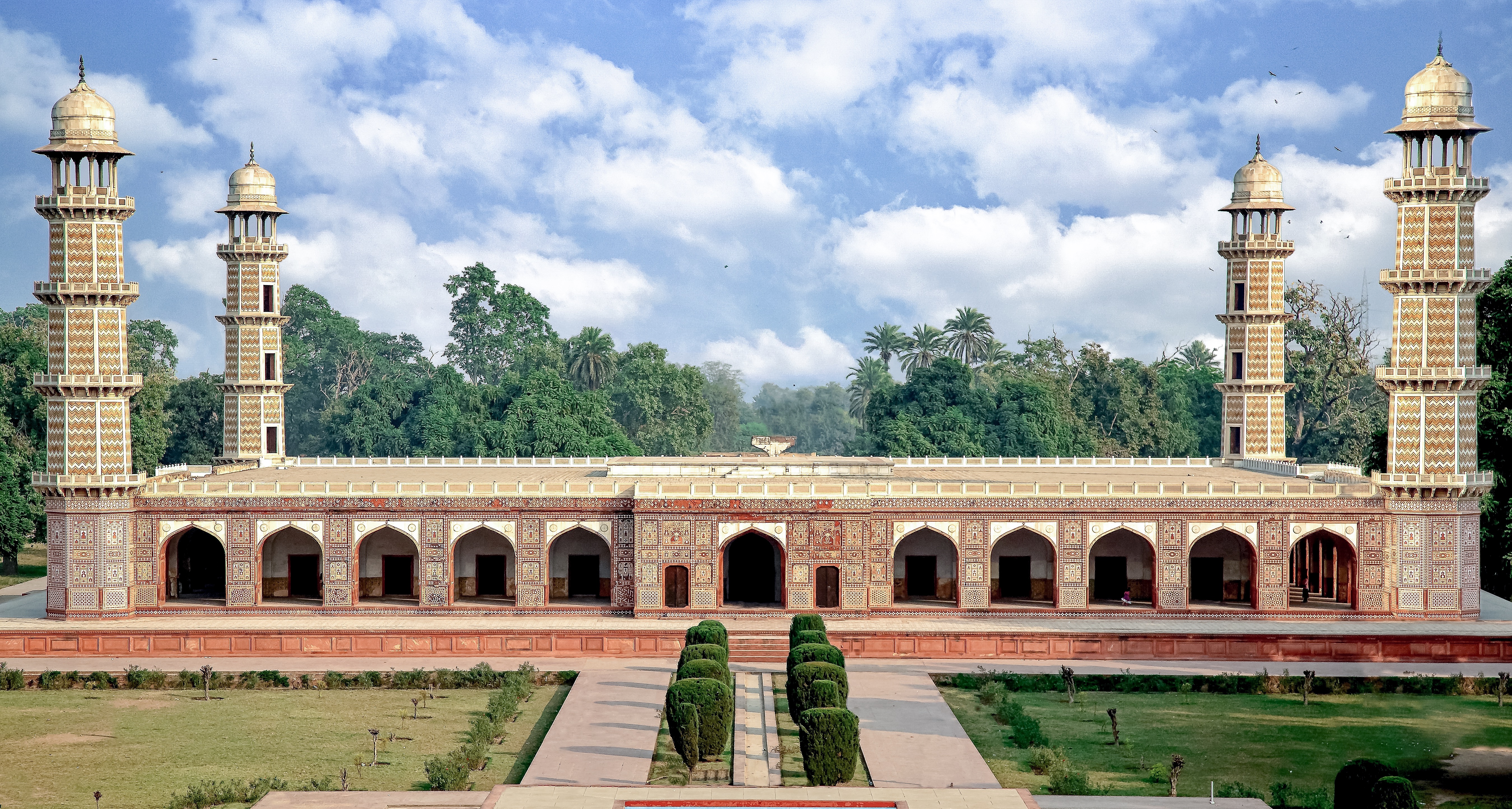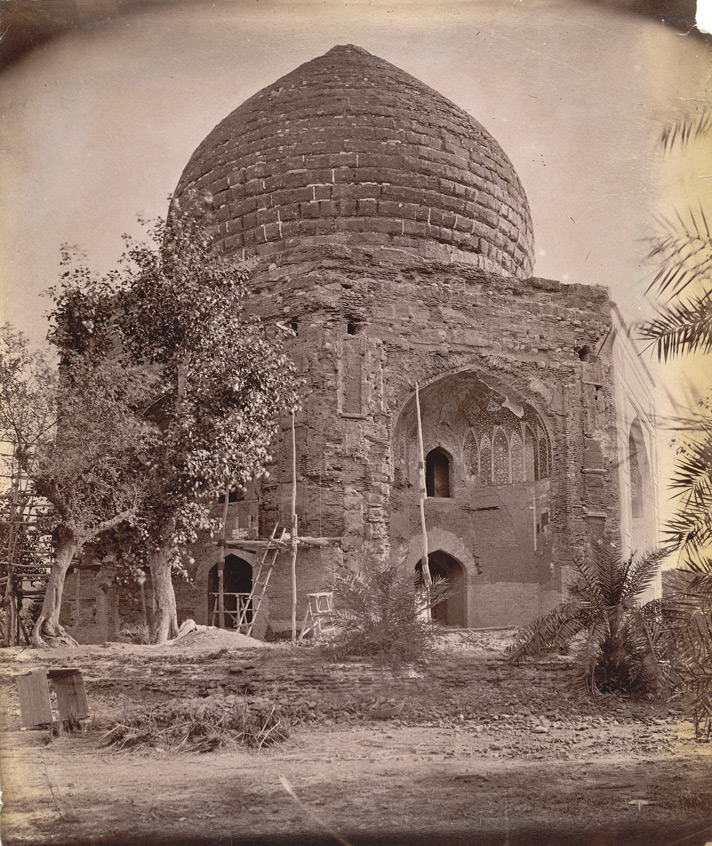|
Tomb Of Nur Jahan
The Tomb of Nur Jahan ( ur, ) is a 17th-century mausoleum in Lahore, Pakistan, that was built for the Mughal empress Nur Jahan. The tomb's marble was plundered during the Sikh era in 18th century for use at the Golden Temple in Amritsar. The red sandstone mausoleum, along with the nearby tomb of Jahangir, tomb of Asif Khan, and Akbari Sarai, forms part of an ensemble of Mughal monuments in Lahore's Shahdara Bagh. Location The mausoleum is located in Shahdara Bagh, across the River Ravi from Lahore. The tomb is part of an ensemble of nearby monuments, including the Tomb of Jahangir, Akbari Sarai, as well as the tomb of Asif Khan. Nur Jahan's tomb was separated from the other monuments by open fields, which were later interrupted by construction of the Lahore-Peshawar Railway Line during the British era. Background Mehr-un-Nissa, bestowed with the title ''Nur Jahan'', meaning "Light of the World," was the fourth child of Asmat Begum and her husband Mirza Ghiyas Beg, who ... [...More Info...] [...Related Items...] OR: [Wikipedia] [Google] [Baidu] |
Tomb Of Nur Jahan 1
A tomb ( grc-gre, τύμβος ''tumbos'') is a repository for the remains of the dead. It is generally any structurally enclosed interment space or burial chamber, of varying sizes. Placing a corpse into a tomb can be called ''immurement'', and is a method of final disposition, as an alternative to cremation or burial. Overview The word is used in a broad sense to encompass a number of such types of places of interment or, occasionally, burial, including: * Architectural shrines – in Christianity, an architectural shrine above a saint's first place of burial, as opposed to a similar shrine on which stands a reliquary or feretory into which the saint's remains have been transferred * Burial vault – a stone or brick-lined underground space for multiple burials, originally vaulted, often privately owned for specific family groups; usually beneath a religious building such as a church ** Cemetery ** Churchyard * Catacombs * Chamber tomb * Charnel house * Church monum ... [...More Info...] [...Related Items...] OR: [Wikipedia] [Google] [Baidu] |
Tomb Of Jahangir
The Tomb of Jahangir ( ur, ) is a 17th-century mausoleum built for the Mughal Emperor Jahangir. The mausoleum dates from 1637, and is located in Shahdara Bagh near city of Lahore, Pakistan, along the banks of the Ravi River. The site is famous for its interiors that are extensively embellished with frescoes and marble, and its exterior that is richly decorated with ''pietra dura''. The tomb, along with the adjacent Akbari Sarai and the Tomb of Asif Khan, are part of an ensemble currently on the tentative list for UNESCO World Heritage status. Location The tomb is located in Shahdara Bagh, northwest of the Walled City of Lahore. The tomb is located across the River Ravi from Lahore, in what was a rural area known for its numerous pleasure gardens. The tomb is located in Jahangir's pleasure garden, the ''Dilkusha'' Garden, which had been laid out in 1557. The Tomb of Asif Khan, built-in 1645, and the Akbari Sarai, built-in 1637, are located immediately west of Jahangir's tomb co ... [...More Info...] [...Related Items...] OR: [Wikipedia] [Google] [Baidu] |
The Express Tribune
''The Express Tribune'' is a daily English-language newspaper based in Pakistan. It is the flagship publication of the '' Daily Express'' media group. It is Pakistan's only internationally affiliated newspaper in a partnership with the ''International New York Times'', the global edition of ''The New York Times''. Headquartered in Karachi, it also prints copy from offices in Lahore, Islamabad, and Peshawar. It was launched on 12 April 1999, in broadsheet format, with a news design distinctive from traditional Pakistani newspapers. Its editorial stance identifies with social liberalism, and its readership is generally on the mainstream left of Pakistani political and social opinion. Topics the newspaper covers include politics, international affairs, economics, investment, sports, and culture. It runs a glossy called ''Express Tribune Magazine'' on Sunday, which includes social commentary, interviews, and a four-page supplement with recipes, reviews, travel advice, blogs, and tech ... [...More Info...] [...Related Items...] OR: [Wikipedia] [Google] [Baidu] |
Ranjit Singh
Ranjit Singh (13 November 1780 – 27 June 1839), popularly known as Sher-e-Punjab or "Lion of Punjab", was the first Maharaja of the Sikh Empire, which ruled the northwest Indian subcontinent in the early half of the 19th century. He survived smallpox in infancy but lost sight in his left eye. He fought his first battle alongside his father at age 10. After his father died, he fought several wars to expel the Afghans in his teenage years and was proclaimed as the "Maharaja of Punjab" at age 21. His empire grew in the Punjab region under his leadership through 1839. Prior to his rise, the Punjab region had numerous warring misls, misls (confederacies), twelve of which were under Sikh rulers and one Muslim. Ranjit Singh successfully absorbed and united the Sikh misls and took over other local kingdoms to create the Sikh Empire. He repeatedly defeated Afghan-Sikh Wars, invasions by outside armies, particularly those arriving from Afghanistan, and established friendly relat ... [...More Info...] [...Related Items...] OR: [Wikipedia] [Google] [Baidu] |
Tomb Of Asif Khan
The Tomb of Asif Khan ( ur, ) is a 17th-century mausoleum located in Shahdara Bagh, in the city of Lahore, Punjab. It was built for the Mughal statesman Mirza Abul Hassan Jah, who was titled ''Asif Khan''. Asif Khan was brother of Nur Jahan, and brother-in-law to the Mughal Emperor Jahangir. Asif Khan's tomb is located adjacent to the Tomb of Jahangir, and near the Tomb of Nur Jahan. Asif Khan's tomb was built in a Central Asian architectural style, and stands in the centre of a Persian-style Charbagh garden. Background Asif Khan was the brother of Empress Nur Jahan, and father of Arjumand Bano Begum, who became the consort of Shah Jahan under the name Mumtaz Mahal. In 1636, he was elevated as ''Khan-e-Khana'' and commander-in-chief and a year later became the governor of Lahore. Asif Khan died on 12 June 1641 in a battle against the forces of rebel Raja Jagat Singh. His tomb was commissioned to be built in the Shahdara Bagh tomb complex in Lahore by Shah Jahan. History Em ... [...More Info...] [...Related Items...] OR: [Wikipedia] [Google] [Baidu] |
Shah Jahan
Shihab-ud-Din Muhammad Khurram (5 January 1592 – 22 January 1666), better known by his regnal name Shah Jahan I (; ), was the fifth emperor of the Mughal Empire, reigning from January 1628 until July 1658. Under his emperorship, the Mughals reached the peak of their architectural achievements and cultural glory. The third son of Jahangir (), Shah Jahan participated in the military campaigns against the Rajputs of Mewar and the Lodis of Deccan. After Jahangir's death in October 1627, Shah Jahan defeated his youngest brother Shahryar Mirza and crowned himself emperor in the Agra Fort. In addition to Shahryar, Shah Jahan executed most of his rival claimants to the throne. He commissioned many monuments, including the Red Fort, Shah Jahan Mosque and the Taj Mahal, where his favorite wife Mumtaz Mahal is entombed. In foreign affairs, Shah Jahan presided over the aggressive campaigns against the Deccan Sultanates, the conflicts with the Portuguese, and the wars with Safavids ... [...More Info...] [...Related Items...] OR: [Wikipedia] [Google] [Baidu] |
Lakh
A lakh (; abbreviated L; sometimes written lac) is a unit in the Indian numbering system equal to one hundred thousand (100,000; scientific notation: 105). In the Indian 2,2,3 convention of digit grouping, it is written as 1,00,000. For example, in India, 150,000 rupees becomes 1.5 ''lakh'' rupees, written as 1,50,000 or INR 1,50,000. It is widely used both in official and other contexts in Afghanistan, Bangladesh, Bhutan, India, Myanmar, Nepal, Pakistan, and Sri Lanka. It is often used in Bangladeshi, Indian, Pakistani, and Sri Lankan English. Usage In Indian English, the word is used both as an attributive and non-attributive noun with either an unmarked or marked ("-s") plural, respectively. For example: "1 ''lakh'' people"; "''lakhs'' of people"; "20 ''lakh'' rupees"; "''lakhs'' of rupees". In the abbreviated form, usage such as "5L" or "5 lac" (for "5 ''lakh'' rupees") is common. In this system of numeration, 100 ''lakh'' is called one '' crore'' and is equa ... [...More Info...] [...Related Items...] OR: [Wikipedia] [Google] [Baidu] |
Rupee
Rupee is the common name for the currencies of India, Mauritius, Nepal, Pakistan, Seychelles, and Sri Lanka, and of former currencies of Afghanistan, Bahrain, Kuwait, Oman, the United Arab Emirates (as the Gulf rupee), British East Africa, Burma, German East Africa (as Rupie/Rupien), and Tibet. In Indonesia and the Maldives, the unit of currency is known as ''rupiah'' and ''rufiyaa'' respectively, cognates of the word rupee. The Indian rupees () and Pakistani rupees () are subdivided into one hundred paise (singular ''paisa'') or pice. The Nepalese rupee (रू) subdivides into one hundred paisa (singular and plural) or four sukaas. The Mauritian, Seychellois, and Sri Lankan rupees subdivide into 100 cents. Etymology The Hindustani word ''rupyā'' is derived from the Sanskrit word ''rūpya'' (), which means "wrought silver, a coin of silver", in origin an adjective meaning "shapely", with a more specific meaning of "stamped, impressed", whence "coin". It is derived f ... [...More Info...] [...Related Items...] OR: [Wikipedia] [Google] [Baidu] |
Jahangir
Nur-ud-Din Muhammad Salim (30 August 1569 – 28 October 1627), known by his imperial name Jahangir (; ), was the fourth Mughal Emperor, who ruled from 1605 until he died in 1627. He was named after the Indian Sufi saint, Salim Chishti. Early life Prince Salim was the third son born to Akbar and his favourite Queen Consort, Mariam-uz-Zamani in Fatehpur Sikri on 30 August 1569. He had two elder brothers, Hassan Mirza and Hussain Mirza, born as twins to his parents in 1564, both of whom died in infancy. Since these children had died in infancy, Akbar sought the blessing of holy men for an heir-apparent to his empire. When Akbar was informed of the news that his chief Hindu wife was expecting a child, an order was passed for the establishment of a royal palace in Sikri near the lodgings of Shaikh Salim Chisti, where the Empress could enjoy the repose being in the vicinity of the revered saint. Mariam was shifted to the palace established there and during her pregnancy, Akba ... [...More Info...] [...Related Items...] OR: [Wikipedia] [Google] [Baidu] |
Akbar
Abu'l-Fath Jalal-ud-din Muhammad Akbar (25 October 1542 – 27 October 1605), popularly known as Akbar the Great ( fa, ), and also as Akbar I (), was the third Mughal emperor, who reigned from 1556 to 1605. Akbar succeeded his father, Humayun, under a regent, Bairam Khan, who helped the young emperor expand and consolidate Mughal domains in India. A strong personality and a successful general, Akbar gradually enlarged the Mughal Empire to include much of the Indian subcontinent. His power and influence, however, extended over the entire subcontinent because of Mughal military, political, cultural, and economic dominance. To unify the vast Mughal state, Akbar established a centralised system of administration throughout his empire and adopted a policy of conciliating conquered rulers through marriage and diplomacy. To preserve peace and order in a religiously and culturally diverse empire, he adopted policies that won him the support of his non-Muslim subjects. Eschewing t ... [...More Info...] [...Related Items...] OR: [Wikipedia] [Google] [Baidu] |
Iran
Iran, officially the Islamic Republic of Iran, and also called Persia, is a country located in Western Asia. It is bordered by Iraq and Turkey to the west, by Azerbaijan and Armenia to the northwest, by the Caspian Sea and Turkmenistan to the north, by Afghanistan and Pakistan to the east, and by the Gulf of Oman and the Persian Gulf to the south. It covers an area of , making it the 17th-largest country. Iran has a population of 86 million, making it the 17th-most populous country in the world, and the second-largest in the Middle East. Its largest cities, in descending order, are the capital Tehran, Mashhad, Isfahan, Karaj, Shiraz, and Tabriz. The country is home to one of the world's oldest civilizations, beginning with the formation of the Elamite kingdoms in the fourth millennium BC. It was first unified by the Medes, an ancient Iranian people, in the seventh century BC, and reached its territorial height in the sixth century BC, when Cyrus the Great fo ... [...More Info...] [...Related Items...] OR: [Wikipedia] [Google] [Baidu] |
Mirza Ghiyas Beg
Mirza Ghiyas Beg ( fa, مرزا غياث بيگ), also known by his title of I'timad-ud-Daulah ( fa, اعتماد الدوله), was an important Persian people, Persian official in the Mughal empire, whose children served as wives, mothers, and generals of the Mughal emperors. Born in Tehran,Mirza Ghiyas Beg belonged to a family of poets and high officials. Nevertheless, his fortunes fell into disfavor after the death of his father in 1576. Along with his pregnant wife Asmat Begum, and his three children, they immigrated to India. There he was received by the Mughal emperor Akbar (r. 1556-1605), and was enrolled into his service. During the latters reign, Ghiyas Beg was appointed treasurer for the province of Kabul. His fortunes further increased during the reign of Akbar's son and successor Jahangir (r. 1605-1627), who in 1611 married his daughter Nur Jahan and appointed Mirza Ghiyas Beg as his Prime minister. By 1615,Mirza Ghiyas Beg had risen to further prominence, when he wa ... [...More Info...] [...Related Items...] OR: [Wikipedia] [Google] [Baidu] |







